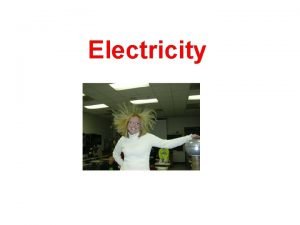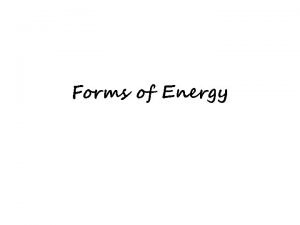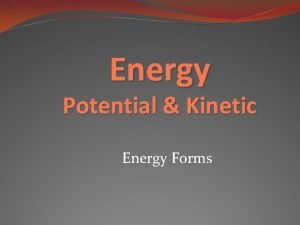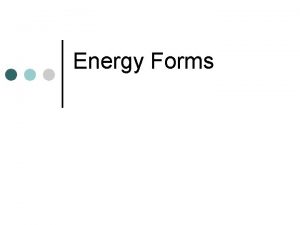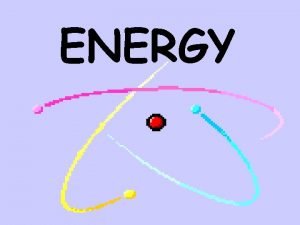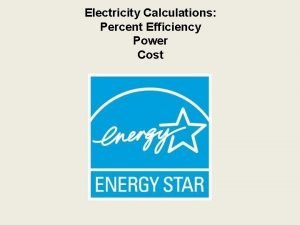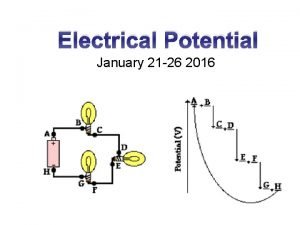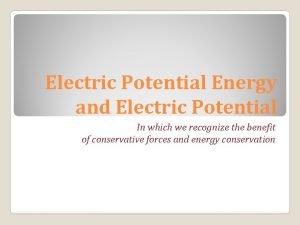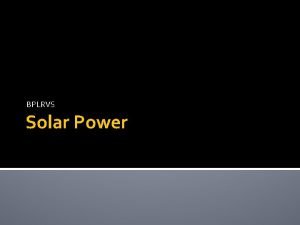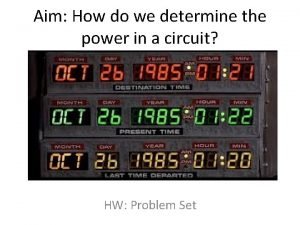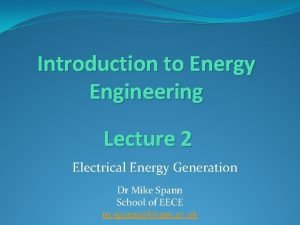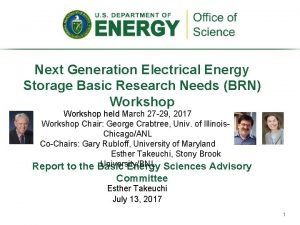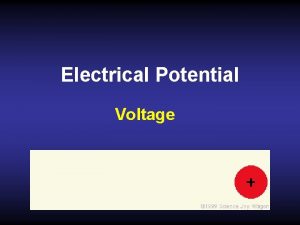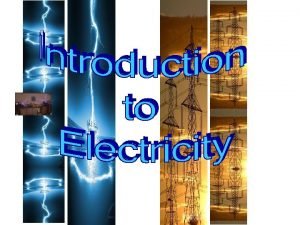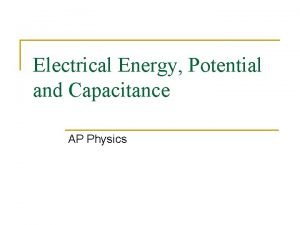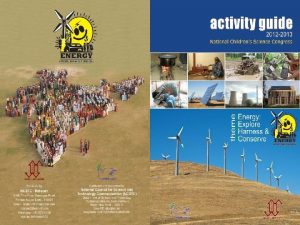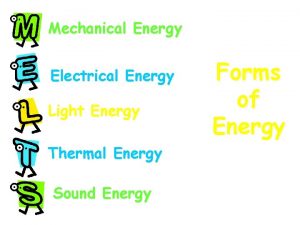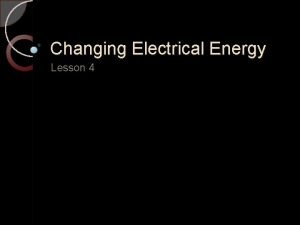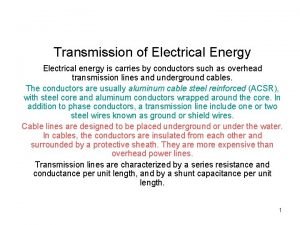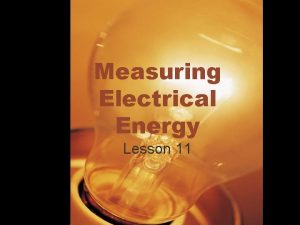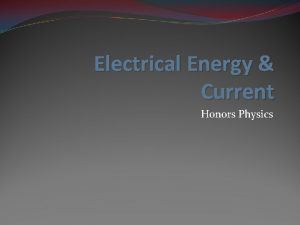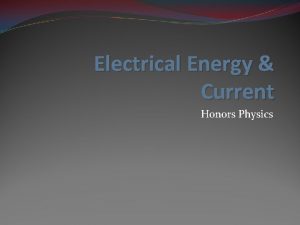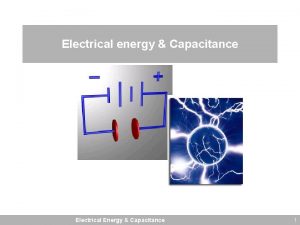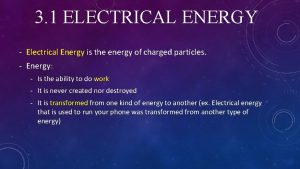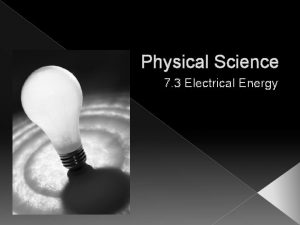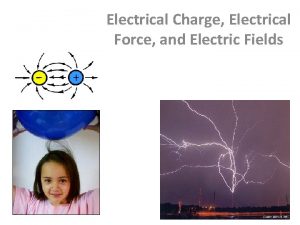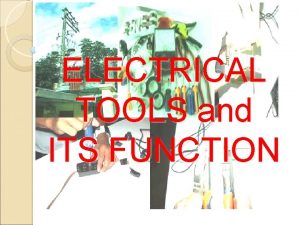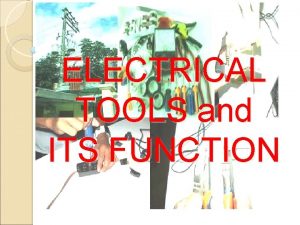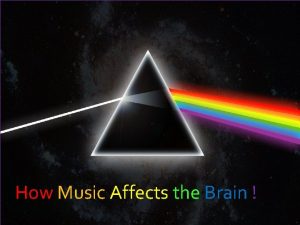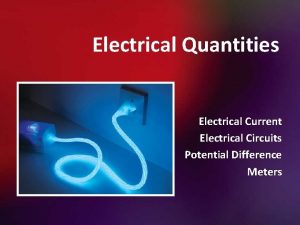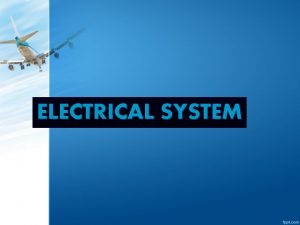The Use of Electrical Energy Affects Society and
















































- Slides: 48

The Use of Electrical Energy Affects Society and the Environment CHATPER 4: ELECTRICITY

4. 1 – Electrical Energy Sources and Alternatives UNIT D: ELECTRICITY

Electrical Energy Sources and Alternatives �Around the world, about 65% of all electric power is generated by burning oil, coal, or natural gas. These fuels are called fossil fuels because they are formed from the decomposition of plants and animals.

Using Heat to Generate Electricity �Coal can be used to turn a generator. �First, the coal is powdered, then blown into a combustion chamber and burned to release heat. �The heat boils water and creates steam under high pressure and temperature. �The high pressure steam drives a large turbine. �The turbine shaft rotates large electromagnetic coils in the generator to produce electricity. �Oil or natural gas can also be burned instead of coal in the combustion chamber.

Using Heat to Generate Electricity http: //www. youtube. com/watch? v=Se. XG 8 K 5_Uv. U

Using Heat to Generate Electricity �Nuclear reactors can also be used as a way to provide heat for a steam operated generator. In nuclear reactors, heavy elements such as uranium are split in chain reactions known as nuclear fission, which results in large amounts of energy being released http: //www. youtube. com/watch? v=c. Xvc 5 j. QVk. VI

Using Heat to Generate Electricity �The Earth’s core also provides a lot of heat that can be used to generate electricity. The heat from the Earth’s core causes the water to heat up and be released as steam. This energy is referred to as geothermal energy which can be harvested to drive turbines. http: //www. youtube. com/watch? v=ajqi. Pe_9 Ko

Using Heat to Generate Electricity �Biomass can also be used as a heat source. �Most accurately describes as garbage, it consists of decomposed garbage and the gases it releases as well as yard clippings, dead trees, unused crops, and food -based garbage, all of which can be burned to produce steam.

Using Heat to Generate Electricity �Cogeneration is also another process which uses the waste energy from a process for another purpose, such as heating or generating electricity. �For example: glass manufacturing, the waste heat produced from the manufacturing process can be used to produce steam.

Using Water Power to Generate Electricity �About 20% of the world’s electricity is generated by hydro-electric power plants. This process captures the energy from falling water. �Some plants like Niagara Falls use the flow from the waterfall, but most use a dam across a river to store water in a reservoir. �Water is directed through a channel called a penstock to a large paddle-covered turbine. �The rushing water spins the turbine, which is connected to a generator in the same way as a steamdriven turbine.

Using Water Power to Generate Electricity http: //www. youtube. com/watch? v=rn. PEtw. Qtm. GQ

Alternative Energy Sources �There are four types of alternative energy sources: 1. 2. 3. 4. Tides Wind Sunlight Fuel cells

Tides �Moving water from tides can also provide power to turbines to run generators. When the tide comes in, the water is trapped in a reservoir and then let out past the turbines. �There are not many tidal stations in the world because of difficulty of finding appropriate locations

Wind �Wind energy can be harnessed to turn a shaft. �The amount of electricity that a single windmill can produce is limited, but a number of windpowered generators can be connected together in “wind farms” to produce larger amounts of electrical energy.

Sunlight �Scientists began using silicon based solar cells are very efficient at producing current. �It is common to find solar modules and arrays connected together to power everything from calculators to spacecraft.

Fuel Cells �Batteries are convenient source of electricity for portable devices. �However, large banks of batteries are rarely used because they are expensive and bulky. � Rechargeable batteries are used to provide backup power for emergency lights and computer systems. �However, these batteries produce electricity only after being charged by using electricity from an external source.

Fuel Cells �Rechargeable batteries are never 100% efficient; therefore they actually use more electricity than the produce. � New research is in developing fuel cells which generate electricity directly from a chemical reaction with a fuel such as hydrogen. More fuel is added as electricity is produced so the cell is no used up as an ordinary cell would be

Renewable and Non-renewable Energy �Alberta is known for its coal reserves and has enough to last the next 200 years at current consumption rates. �However, coal is non-renewable resource – it cannot be replaced as it is used up. Crude oil and natural gas, also found in Alberta will all eventually run out.

Renewable and Non-renewable Energy

Renewable and Non-renewable Energy http: //www. youtube. com/watch? v=p. BTn. Vo. EIb 98

Renewable and Non-renewable Energy �In contrast, renewable resources can be renewed or replenished in relatively short periods of time. Some are continually replenished. � Wind energy, tidal energy, solar energy, geothermal energy, and biomass are resources that naturally renew themselves. � If tree harvesting is managed carefully, replanting can ensure that wood supplies for energy can last indefinitely. However, if wood is used faster than the trees can be grown, then the renewable resource cannot meet energy needs indefinitely.

Check and Reflect �Page 350 Questions 1, 3 -9

4. 2 – Electricity and the Environment UNIT D: ELECTRICITY

Air Pollution �The burning of fossil fuels results in the release of many problem-causing substances into the atmosphere. �For example, when coal is burned, it leaves behind a powdery ash. Some of this ash is carried up the smokestack and released into the atmosphere which is referred to as fly ash.

Air Pollution �This is a concern because the ash contains small amounts of mercury, which is poisonous and can damage the nervous system. � Other pollutants that are released include: sulfur dioxide, nitrogen oxides, and carbon dioxides. � Many which result in acid rain and increased global warming.

Other Environmental Effects �Most coal comes from strip mines. This process is used when deposits are near the surface. �This type of mining removes all plants and animals from large areas of land. � Although the land can be reclaimed by replacing the soil, the original natural environment is not usually restored 100%.

Other Environmental Effects �Oil and gas wells can also affect the surrounding areas; some of these deposits contain poisonous gases which if not handled properly, can be released into the environment. These concentrations are measured for human safety. � https: //www. neb-one. gc. ca/sftnvrnmnt/sft/dshbrd/mp/index-eng. html

Other Environmental Effects �In electricity generation, steam turbines often release a great deal of warm water into nearby lakes and streams which increases the water temperature and alters the fresh water ecology and sometimes kill fish. �Power generation from nuclear reactors create radioactive wastes that remain dangerous for thousands of years, Hydro-electric dams produce no pollutants, but their dams flood many hectares of land alter the ecosystems of rivers.

Other Environmental Effects �Wind farms and solar cell arrays also require large tracts of land to generate practical amounts of energy. Tidal or wave generators may disrupt ocean habitats. However, the “Green” sources of energy – especially wind, tide, and geothermal – harm the environment much less than fossil fuels do.

Conserving Energy and Non-Renewable Resources �Reserves of oil and gas are decreasing, but it is likely that they will last your lifetime. So why bother conserving energy? � If demand for energy decreases, there is a lower demand for the resources that fuel electrical generating plants. �The plants would then be able to decrease their production or cease to operate, which leads to less pollution. �When your actions lead to a lower demand on natural resources, you are practicing energy conservation.

Conserving Energy and Non-Renewable Resources �The electric car – if you want to conserve fossil fuels you might consider buying an electric car to reduce pollution. � Electric cars reduce the need for gasoline, which comes from oil.

Conserving Energy and Non-Renewable Resources �Burning less gasoline conserves oil reserves and reduces pollution. �The electric car, however, must get electricity from somewhere for its rechargeable batteries. �If a coal fire plant supplies this electricity, you may not be saving fossil fuels or reducing pollution. �However, if a hydroelectric plant, or wind farm provides this power, fossil fuels will be conserved and pollution will decrease. � Both personal and societal decisions must be taken into account when considering conservation.

A Sustainable Future �Conserving energy means moving toward sustainability. Sustainability means using resources at a rate that can be maintained indefinitely. � If we do not achieve sustainability, future generations may not be able to support themselves. �We may never be able to achieve complete sustainability, but the decisions we make personally and as a society can move us closer to this goal. �An example of personal decision would be choosing public transit rather than driving your car. An example of a societal decision is the use of low wattage street lights.

Check and Reflect �Check and Reflect P. 353 Questions 1 -5, 7, 8

4. 3 - Electrical Technology and Society UNIT D: ELECTRICITY

Benefits of Electrical Technologies �Many electrical devices and inventions came out of a desire for speed or convenience. For example, doing laundry. � Before the invention of the washing machine, it could take a whole day to complete the washing. �Now, machines do the washing, rinsing, and drying, freeing up people to do other things. Electronic devices also make completing a variety of tasks more quickly and efficiently, and give us more time for other activities.

Drawbacks of Electrical Technologies �More technology means that more resources are needed to manufacture and operate devices. They can also make sustainability more difficult to achieve. � As technology advances making other devices obsolete, this creates the problem of discarded waste. Some technologies are also very expensive for some countries to adopt which excludes them from the benefits of technological advancement



Computers and Information �Computers have revolutionized the way we accomplish many tasks, including writing, calculations, and communications. �Computers convert all information even audio and visual into numbers and then perform calculations with these numbers. �Computers use binary numbers, that is numbers with just ones and zeros.

Computers and Information �These numbers correspond to the one and off states of millions of transistors in the microcircuits. �The data is converted to strings of digits, this method of storing and transmitting information is often referred to as a digital technology

Electricity and Computers � Different techniques can be used to store and transmit information, but all of them take advantage of electrical current in one way or another. � For example, a compact disc (CD) player scans a CD with a laser. � Tiny pits stamped into the surface of the shiny disc cause the laser light to be reflected in pulses. � A photodetector converts the light pulses into electrical pulses. This produces a digital signal with exactly the same sequence of ones and zeros as the master recording used to make the CD.

Electricity and Computers �Electrical signals control all the functions of the computer, including the images on the screen and the sounds from the speakers. �If these electrical signals can control your computer, could signals also be sent to control a remote computer? Such signals are the key to networking and the Internet.

Electricity and Computers

Electrical Transmission of Information �Electronic storage of information is a huge benefit to society. Information is cheaper to store, easier to find, and much more compact. �For example, a single digital video disc (DVD) can store more information than a whole set of encyclopedia’s. � Electronic media can store audio and video, as well as text, which often makes information easier to understand more entertaining.

Electrical Transmission of Information � There are some concerns with about the explosion of information and electronic technology. One issue is access to technology. � Some countries are too poor to establish the infrastructure necessary to connect computers and transmit information. � Another issue is privacy. Data transmission is not always secure. Files, such as financial and personal information, sometimes fall into the wrong hands. � “Hackers” attempt to break into networks either to steal information or to cause damage for the sake of challenge or for no reason at all.

Electrical Transmission of Information �Another concern is information overload. With greater and greater capacity to store information, it becomes increasingly more difficult to find the particular piece of information that you need. � Search engines were developed to help sort through the vast amount of information on the Internet. � A search engine is an application that searches the Internet for keywords or phrases that you enter in a query field.

Check and Reflect �Check and Reflect p. 358 Questions 1, 2, 3, 7, 8
 Thinking affects our language, which then affects our:
Thinking affects our language, which then affects our: Electrical energy equations
Electrical energy equations How to convert mechanical energy to electrical energy
How to convert mechanical energy to electrical energy Strong electric current
Strong electric current Energy energy transfer and general energy analysis
Energy energy transfer and general energy analysis Energy energy transfer and general energy analysis
Energy energy transfer and general energy analysis Pro and cons of biomass
Pro and cons of biomass Gertler econ
Gertler econ What is catalyst and how it affects reaction rate
What is catalyst and how it affects reaction rate Penny insulator or conductor
Penny insulator or conductor What is electrical energy
What is electrical energy Radiant energy
Radiant energy Energy conversion examples
Energy conversion examples Electrical energy formula
Electrical energy formula If a battery provides a high voltage it can
If a battery provides a high voltage it can Electric potential energy definition
Electric potential energy definition Electric potential
Electric potential Raghunath iyer
Raghunath iyer Electrical energy
Electrical energy Electrical energy
Electrical energy Electrical energy
Electrical energy Next generation electrical technologies
Next generation electrical technologies Uses of electrical energy
Uses of electrical energy Electrical kinetic energy
Electrical kinetic energy Electrical potential energy
Electrical potential energy Electrical energy drawing
Electrical energy drawing Potential electric energy formula
Potential electric energy formula Energy formula
Energy formula Hát kết hợp bộ gõ cơ thể
Hát kết hợp bộ gõ cơ thể Ng-html
Ng-html Bổ thể
Bổ thể Tỉ lệ cơ thể trẻ em
Tỉ lệ cơ thể trẻ em Voi kéo gỗ như thế nào
Voi kéo gỗ như thế nào Chụp phim tư thế worms-breton
Chụp phim tư thế worms-breton Hát lên người ơi alleluia
Hát lên người ơi alleluia Môn thể thao bắt đầu bằng chữ đua
Môn thể thao bắt đầu bằng chữ đua Thế nào là hệ số cao nhất
Thế nào là hệ số cao nhất Các châu lục và đại dương trên thế giới
Các châu lục và đại dương trên thế giới Công thức tính thế năng
Công thức tính thế năng Trời xanh đây là của chúng ta thể thơ
Trời xanh đây là của chúng ta thể thơ Mật thư tọa độ 5x5
Mật thư tọa độ 5x5 Phép trừ bù
Phép trừ bù Phản ứng thế ankan
Phản ứng thế ankan Các châu lục và đại dương trên thế giới
Các châu lục và đại dương trên thế giới Thể thơ truyền thống
Thể thơ truyền thống Quá trình desamine hóa có thể tạo ra
Quá trình desamine hóa có thể tạo ra Một số thể thơ truyền thống
Một số thể thơ truyền thống Cái miệng xinh xinh thế chỉ nói điều hay thôi
Cái miệng xinh xinh thế chỉ nói điều hay thôi Vẽ hình chiếu vuông góc của vật thể sau
Vẽ hình chiếu vuông góc của vật thể sau



